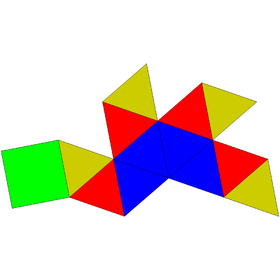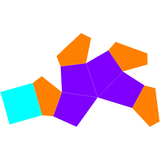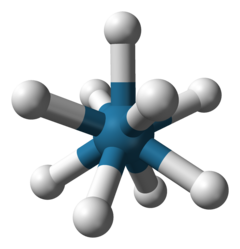Gyroelongated square pyramid
Appearance
| Gyroelongated square pyramid | |
|---|---|
 | |
| Type | Johnson J9 – J10 – J11 |
| Faces | 12 triangles 1 square |
| Edges | 20 |
| Vertices | 9 |
| Vertex configuration | 1(34) 4(33.4) 4(35) |
| Symmetry group | C4v, [4], (*44) |
| Rotation group | C4, [4]+, (44) |
| Dual polyhedron | - |
| Properties | convex |
| Net | |
 | |
In geometry, the gyroelongated square pyramid is one of the Johnson solids (J10). As its name suggests, it can be constructed by taking a square pyramid and "gyroelongating" it, which in this case involves joining a square antiprism to its base.
A Johnson solid is one of 92 strictly convex polyhedra that is composed of regular polygon faces but are not uniform polyhedra (that is, they are not Platonic solids, Archimedean solids, prisms, or antiprisms). They were named by Norman Johnson, who first listed these polyhedra in 1966.[1]
Applications
The Gyroelongated square pyramid represents the capped square antiprismatic molecular geometry:
Dual polyhedron
The dual of the gyroelongated square pyramid has 9 faces: 4 kites, 1 square and 4 pentagonal.
| Dual gyroelongated square pyramid | Net of dual |
|---|---|

|

|
See also
External links
- ^ Johnson, Norman W. (1966), "Convex polyhedra with regular faces", Canadian Journal of Mathematics, 18: 169–200, doi:10.4153/cjm-1966-021-8, MR 0185507, Zbl 0132.14603.

